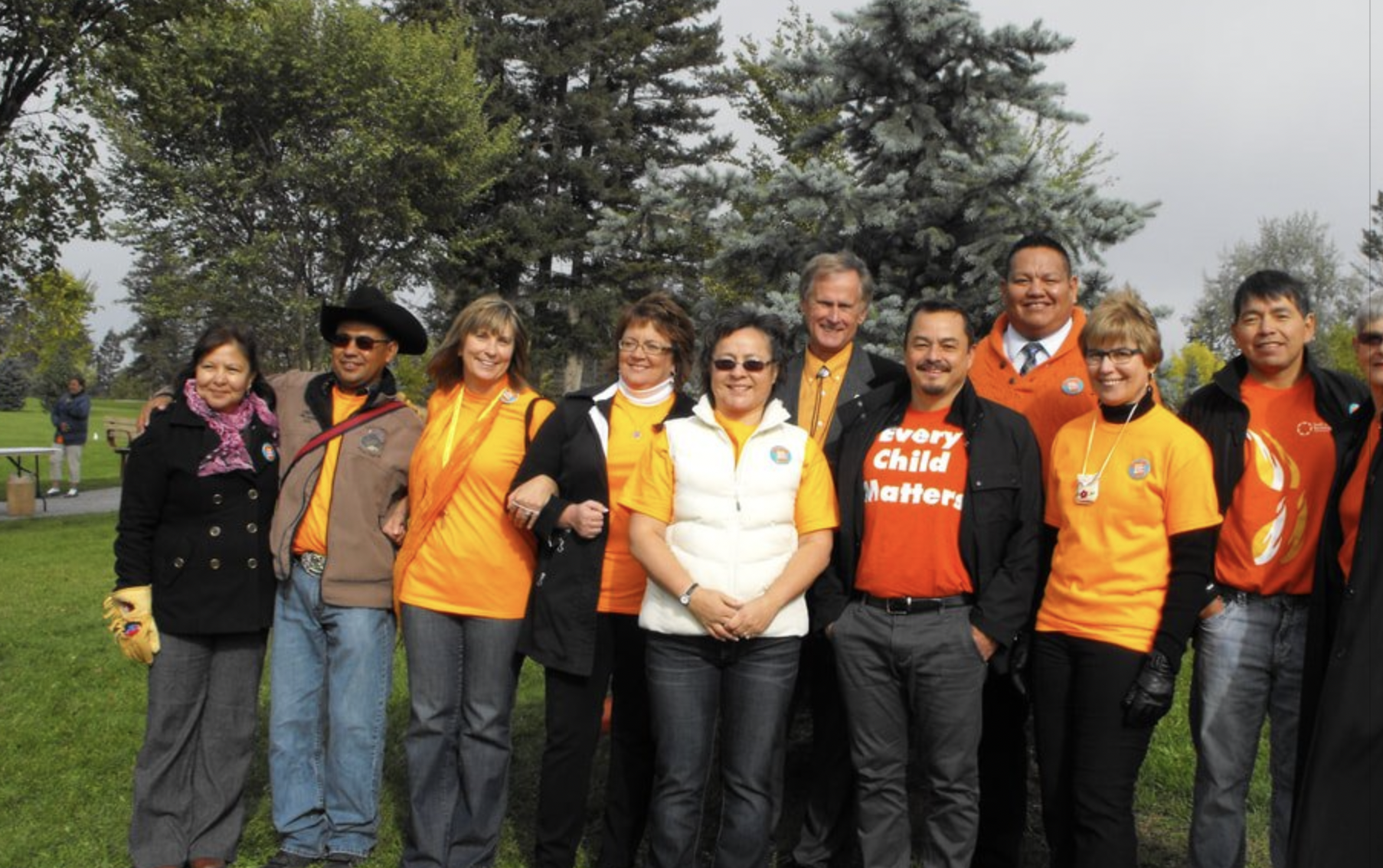Comments
ACCORDING TO LIZ - Tomorrow, September 30, marks Canada’s National Day for Truth and Reconciliation.
The day, first formally celebrated as a national holiday in 2021, honors the survivors of the Indian residential school system in Canada, as well as the children who never returned home from them, and their families and communities.
The acknowledgement of and respect for abuses in the past grew out of the Indigenous-led grassroots movement Orange Shirt Day which initially sought to raise awareness of the individual, family and community inter-generational impacts of residential schools, and to promote the concept of “Every Child Matters.”
The Orange Shirt movement originated with Phyllis Webstad, a residential school survivor from the Stswecem’c Xgat’tem First Nation (about four hours northwest of Kamloops, BC). In 1973, her grandmother bought her a brand-new orange shirt for the first day of school.
But when 6-year-old Phyllis arrived at the St. Joseph Mission residential school wearing her new shirt, it and all her clothes were immediately taken away as a tactic to de-Indianize the Indian.
The color orange always reminded Phyllis of that loss and how the children’s feelings were discounted, how nobody cared, how little indigenous kids were worth nothing in the eyes of the Canadian government, and became the symbol of the stripping away of culture, freedom and self-esteem experienced by indigenous children over generations.

Her advocacy and the advocacy of thousands of others, both indigenous and those ashamed by their government, led to Orange Shirt Day being observed annually in Canada every September 30 since 2013 to commemorate the victims and survivors of Indian Residential Schools.
Inspired by Phyllis’s story, orange shirts and orange shirt pins are worn to call awareness to the harmful legacies of residential schools. And affirm that every child matters.
Eight years later Canada designated September 30 as a federal holiday, the National Day for Truth and Reconciliation to acknowledge the history of residential schools, honoring their victims and survivors, as well as their families and communities.
That May of 2021, the remains of 215 children – some as young as three years old – were uncovered on the grounds of Kamloops Indian Residential School following an investigation initiated by the Tk’emlúp te Secwépemc band.
Additional investigations were launched at the sites of other residential schools and, by that September, over eighteen hundred graves had been uncovered.
The Truth and Reconciliation Commission was established on June 1, 2008, and ran through 2015 documenting the consequences of the Canadian residential school system. It concluded that the attempt to forcefully assimilate indigenous communities through the 140 “schools” was a cultural genocide.
Public commemoration and acknowledgment of the tragic and painful history and the after-effect impact of residential schools is a key component of the reconciliation process.
In his official capacity, the late Pope Francis made a pilgrimage of penance to meet Indigenous survivors in Canada in July 2022.
Under his guidance, in March of 2023 the Catholic Church formally repudiated the Doctrine of Discovery that since the 1400s had justified European colonization by claiming lands not inhabited by Christians as available for discovery and ownership.
The same Doctrine of Discovery drove white exploitation of the United States and, while a number of past atrocities against Native Americans and their confinement to reservations are acknowledged (possibly soon-to-be-buried by Lord Trump’s whitewashing of American history), many today are unaware that what happened in Canada was equally prevalent south of the border.
Was as bad, or worse.
Native-born children were torn from their families, given American haircuts and clothing, and indoctrinated in white customs and a skewed perception of U.S. history. They were punished for their culture. The bones of their ancestors were dug up and put on display in museums for people to gawk at.
During the western expansion following the Civil War, priority was given by American leadership to kill, annihilate, or assimilate Indians and eradicate tribal culture to facilitate the seizure of land for white settlers.
It was the era that also gave rise to the celebration of cowboys and the demonization of native-born Americans.
Technically it started with the passage of The Civilization Fund Act in 1819, encouraging education be provided to native children to impose a “civilization process."
This eventually led to the Indian Boarding Schools, established to deliberately remove elders’ influence on children born into indigenous cultures, to brainwash them, replacing tribal values and beliefs with mainstream American culture through education.
Between 1860 and 1978, there were over 350 boarding schools across 30 states “educating” over 60,000 native children, operated by Christian missionaries as well as the government.
The Carlisle Indian School in Pennsylvania was founded by Richard Henry Pratt based on a program he designed while overseeing Fort Marion Prison in St. Augustine, Florida, where he experimented with Native American assimilation education on imprisoned and captive indigenous peoples.
Pratt is best known for his statement: “A great general has said that the only good Indian is a dead one. In a sense, I agree with the sentiment, but only in this: that all the Indian there is in the race should be dead. Kill the Indian in him, and save the man.”
Attendance at boarding school was mandatory and, upon arrival, children were given Anglo names, bathed in kerosene, and had their traditional garb replaced by military-style clothing. Boys’ hair would be shaved off and girls’ cut to a short bob.
Education emphasized physical and subservient trades – blacksmithing, shoemaking, farming, cooking, cleaning, sewing, and laundry – making the children marketable to mainstream American society.
Students were forced to convert to Christianity and celebrate American religious and secular holidays including Columbus Day. Any academic subjects taught emphasized American priorities such as the importance of private property and material wealth.
Some students were “placed” in American families for up to a year to further inculcate them in the value systems of the conqueror but basically exploited for domestic and manual labor.
As in Canada, Native American students were not allowed to speak their own languages. They were forced to speak English regardless of their fluency and disciplined if they didn’t.
Punishments were severe, ranging from confinement to heavy labor to corporal chastisement. Many children were neglected, suffering from malnutrition and a lack of medical attention. Physical, sexual, cultural, and spiritual abuses were prevalent, including being compelled to watch distressful Cowboys-and-Indians movies where the latter were constantly disparaged as dirty and evil.
Contrary to the view that filthy Indians were hotbeds of disease that then infected white communities, it was how poorly the white majority treated native peoples that was the underlying cause of almost all problems.
Conditions in boarding schools made those children more susceptible to tuberculosis, flu, trachoma, other infections... and death. Parents were rarely informed of these. Some would eventually learn of a child’s death after burial in school cemeteries. Others were buried in unmarked graves.
As with the dead in Gaza often those who died were blamed for their own demise.
And, as will indubitably be the result in Gaza, survivors of these schools were scarred for life.
These traumas also afflicted the lives of their families and communities leading to mental health issues and alcoholism, poverty and poor physical health. Often, distorted identity issues due to the imposition of mainstream American values caused the negative stereotypes which continue to impact Native American communities.
Even today, tribal children face severe challenges within the public education system. Curricula are rarely relevant to their experience and culture, and create classroom challenges.
Statistics show native students to already have fallen behind their peers in 4th-grade reading and 8th-grade math assessments, are disproportionately suspended from school, 50% more likely to die in a homicide or suicide, and twice as likely to drop out of high school. Putting them dead last in line to climb the ladder of success.
Of Indian boarding schools run by the American government during this period, three were in California.
The state’s first elected civilian governor was Peter Hardeman Burnett, a former slaveholder from Tennessee who vowed to create an exclusively white American West.
When he failed to push through laws banning black people from the state despite the widespread white supremacist attitudes of the time, he made it his mission to stamp out all vestiges of Native American customs declaring that “a war of extermination will continue to be waged between the races until the Indian race becomes extinct.”
The Office of Native Affairs called on county administrators to ban tribal dances and feasts which were condemned as malevolent ploys to cover immoral acts.
Burnett’s so-called Act for the Government and Protection of Indians authorized whites to drive native peoples from their ancestral lands into indentured servitude. Native children often suffered horrific abuse as a result of a law that professed to send them to white families for self-improvement but, instead, created a form of legalized child slavery.
Kidnappers could sell Indian children for “$30 to $150 depending on their quality” and, if recovered, local officials would offer them to local white residents as “apprentices” instead of returning them to their families.
Stringent cultural assimilation programs imposed white Christian norms on native schoolchildren, punishing them for using their own language or observing tribal traditions.
“Students” resisted – secretly speaking their own tongue, refusing to work, running away. Reports of physical and sexual abuse proliferated.
Native people were not even considered U.S. citizens until the passage of the Indian Citizenship Act in 1924, and it wasn’t until 1978 that parents gained the right to prevent family separation in California.
In 1892 the United States government established the Perris Indian School as the first non-reservation boarding school for Native American children in California. Its objective: to assimilate students into “civilized” society.
The school was relocated to Riverside as the Sherman Institute at the urging of local hotel owner Frank Miller who capitalized on tourists’ interest in Indian culture to attract business to his Mission Inn. However, the school still focused on vocational training, and it was not until 1971 that it was accredited as a pre-college academic institution.
Orange Shirt Day in Canada honors the children who lost their lives in Canada’s residential school system as well as those who survived, their families and communities.
By bravely shared stories of loss, trauma, and resilience the victims brought this tragic legacy mainstream, and all Canadians are invited to consider how they can support change and meaningfully contribute to healing and reconciliation.
Even without any direct complicity, through listening to these Indigenous voices, engaging in deeper listening, and taking time for personal reflection, strengthens the mosaic of communities that together form the fabric of the country north of the United States.
They are not alone.
South of the border, from Seattle to Chicago to Niagara Falls in upstate New York, thousands of American turned out for events over the weekend or tomorrow embracing “Every Child Matters,” holding their own Orange Shirt Days to commemorate the tens of thousands of Native Americans who were committed to the traumatizing care of the Indian boarding school system during the 1800s and 1900s.
In the words of Seneca Nation member and Niagara Falls walk organizer Kevin Nephew:
“The journey toward healing is long and difficult. Even now, decades after the residential school doors finally closed, there are generations of Native people who still carry pain and darkness with them every day because of what they experienced at the schools.
“There are Native communities everywhere that still bear the weight of that trauma. We want people to understand what happened and, as important, we want every individual and community that were forever changed by the residential school movement to know that we are walking that healing journey with them.”
All Americans must commit to recognizing the horrors of what happened here, not by paying people off to make it go away but by acknowledging the truth.
Only with open-heart listening and acceptance of the pain of the past can steps be taken towards this country’s own reconciliation with its original inhabitants.






